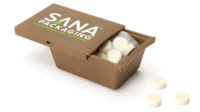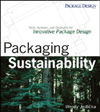The Latest Innovation Techniques Driving the Sustainable Packaging Industry
_web.jpg?1645110028)
Packaging is an integral part of a product in today’s developed world. And yet, with today’s environmental concerns, reducing waste and energy usage while increasing overall product sustainability has been the priority.
A major challenge faced by packaging technology advancement relates to sustainable packaging. Innovation in sustainable packaging technologies can play a vital role in supporting the UN 2030 agenda – “Transforming our World: The 2030 Agenda for Sustainable Development”.
However, sustainable packaging is no longer just recycling-focused; rather, it now has multiple dimensions to qualify — serving consumer preferences and enabling business growth while promoting environmental protection. Other drivers are government regulation, public health and retailers.
As per Future Market Insights (FMI) upcoming research study on Flexible Packaging Paper Market, due to rise in plastic waste caused by packaging, market players around the world are now focusing on biodegradable and recyclable packaging material. Hence, sustainable packaging is no longer a nice-to-have, but an essential part of doing business. In response to the vital needs of sustainable packaging, the industry has been focusing on innovation across three key areas: design, materials and manufacturing techniques.
Packaging Sustainability Objectives Focus on The Following:
- Reducing weight and volume of packaging
- Eliminating or minimizing toxic additives
- Reducing energy consumption
- Creating sustainable business models
Given that the scope of research for sustainable technologies is vast, the current study puts an emphasis only on the relevance of packaging materials in sustainable packaging development. Packaging materials play an important role in the packaging value chain, as it usually comprises of over half of the total cost of packaging.
Evolution of packaging began with natural sources such as bark, leaves, leather, etc. Later, considering their strength and durability properties, glass, metal and ceramics gained popularity. In the early 20th century, milk was commonly transported in glass bottles. However, these materials had their own disadvantages with regard to fragility, flexibility, manufacturing cost, hygiene issues and ease of delivery. This was when thermoplastics came into the picture and replaced the earlier packaging materials. But their disadvantage is that they are not found to be environmentally friendly. With the awareness of environmentally friendly packaging commencing in the late 80’s, research on biodegradable materials began.
Sustainable packaging is steadily improving, and the options are growing. The following are some of the best choices currently out there:
- Corrugated Cardboard and Kraft Folding Carton: These types of sustainable boxes are generally made from a mixture of recycled materials and sustainable forestry-derived material.
- Packing Paper: It is one of the most common options used to protect products inside from damage, and it’s eco-friendly as well. Whether wrapping delicate objects or add stuffing, paper packaging is both recyclable and compostable.
- Reusable Packaging: It is generally viewed as an incredibly eco-friendly option for sustainable packaging if businesses can integrate it with their products. It’s been seen most often as a suitable food packaging option such as glass milk bottles, kegs, pallets, etc.
- Reusable Plastic Totes: Although not a packaging option for every business, reusable plastic totes can be used for transportation and added to packaging for customers to use for easy returns.
- Plant-based Packaging: There are many plant-based sustainable packaging materials emerging that bode well for the future of sustainable packaging. Although somewhat new to the market, plant-based packaging is starting to make its mark on the packaging industry.
- Mushroom Packaging: This is still a developing option in the sustainable packaging material, so expect to see more research and development go into this type of packaging. Mushroom packaging uses the mycelium, the mushroom’s root system, which turns into a mold. It’s then baked to form a protective cushioning for packaging.
- Cornstarch Packaging: Another organic, sustainable packaging material, cornstarch packaging, is fast becoming a popular choice for those seeking sustainable box material or sustainable food packaging. Derived from maize plants, cornstarch packaging is more like plastic, making it a great alternative when extra protection is needed to secure products inside the packaging.
- Plantable Packaging: This is one of the most creative types of sustainable packaging out there because it allows your customers to feel like they are part of a larger environmental initiative. Plantable packaging is a kind of packaging that has seeds embedded into it. After it’s used, customers can plant the packaging and watch it grow.
Latest Innovation Techniques Driving the Sustainable Packaging Industry
Findings on current innovation trends in sustainable packaging indicate promising progress and novel techniques that will have great impact on offering sustainable packaging solutions. The following are some of the latest technological innovations under research in the field of sustainable packaging:
Synthetic Materials: The major focus of companies on synthetic materials has been towards process improvements enabling reduced density and usage of raw material; and improved recovery and reuse of materials.
Bio-Derived Materials: Companies doing research & development in this area are working towards leveraging inherent properties of bioplastics and enhancing barrier properties, durability, process ability and material improvisation.
Though, a lot of research on bio-derived plastics is focused in material improvisation, there is scope for process innovation as well. Many conventional manufacturers have equipment/processes for synthetic plastics and hence, are hesitant to make separate investments for new equipment favorable for bioplastics.
Bioplastics: Bioplastics are essentially bio-based plastic materials made from sugars found in sugarcane, corn starch, and cassava. As the technology continues to see more investment, it is increasingly coming into focus. As we shift away from petroleum-based plastic, this type of biodegradable plastic is coming into its own as an option for sustainable packaging material.
Dissolvable Packaging: Another emerging sustainable packaging option is dissolvable packaging, with the most promising example being water-soluble packaging. Again, this is being developed as a potential replacement for plastic. We’ve already seen the normalization of this type of packaging with laundry pods and dishwasher pods. Not only is it eradicating single use plastic wrappers, but it makes for a more convenient customer experience.
Most of the current packaging solutions fall within linear economy model which is “take, make and waste”. The foundation of sustainable packaging lies in making a big leap towards a circular economy model which is the “take, make, restore/recover and remake”.
Future Prospects for Research
It is clearly evident that synthetic materials are most preferred across various industrial applications as they are economical, attractive to consumers, and available in abundance. However, fluctuation in prices of synthetic materials and serious initiatives to reduce adverse environmental impact are forcing manufacturers to improvise processing abilities to reduce their usage and accelerate usage of bio-derived materials.
Although, Post-2000 there is a steady growth towards utilization of bio-derived materials, yet they lack pace in comparison to synthetic materials; the reasons being extended time required for development of novel materials, inferior barrier- and mechanical-properties.
Overall, there exists a healthy competition between synthetic materials and bio-derived materials to collectively develop sustainable packaging solutions.
Looking for a reprint of this article?
From high-res PDFs to custom plaques, order your copy today!









